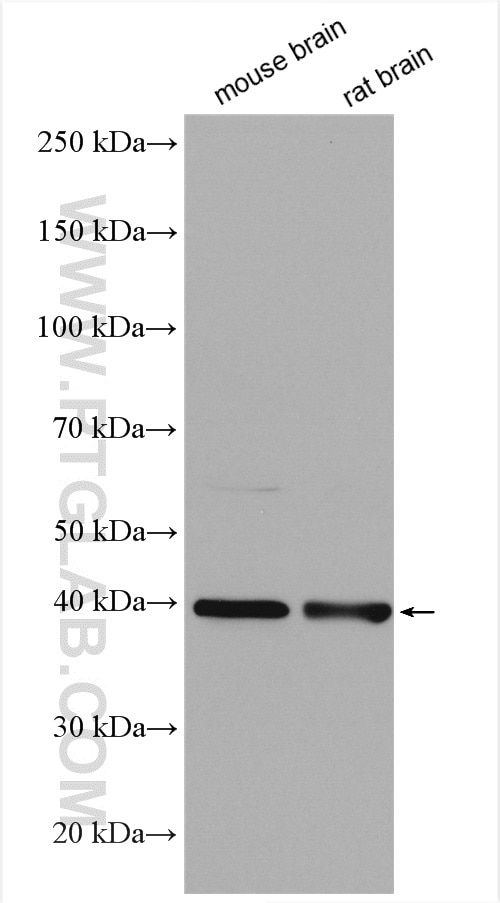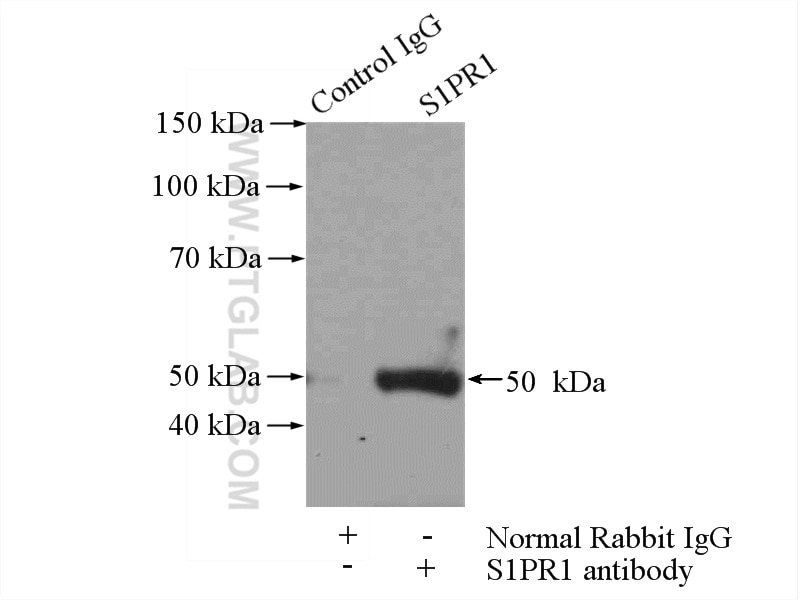Tested Applications
| Positive WB detected in | mouse brain tissue, rat brain tissue |
| Positive IP detected in | mouse brain tissue |
Recommended dilution
| Application | Dilution |
|---|---|
| Western Blot (WB) | WB : 1:1000-1:6000 |
| Immunoprecipitation (IP) | IP : 0.5-4.0 ug for 1.0-3.0 mg of total protein lysate |
| It is recommended that this reagent should be titrated in each testing system to obtain optimal results. | |
| Sample-dependent, Check data in validation data gallery. | |
Published Applications
| KD/KO | See 9 publications below |
| WB | See 45 publications below |
| IHC | See 11 publications below |
| IF | See 12 publications below |
| IP | See 4 publications below |
Product Information
55133-1-AP targets S1PR1/EDG1 in WB, IHC, IF, IP, ELISA applications and shows reactivity with human, mouse, rat samples.
| Tested Reactivity | human, mouse, rat |
| Cited Reactivity | human, mouse, rat |
| Host / Isotype | Rabbit / IgG |
| Class | Polyclonal |
| Type | Antibody |
| Immunogen |
Peptide Predict reactive species |
| Full Name | sphingosine-1-phosphate receptor 1 |
| Calculated Molecular Weight | 43 kDa |
| Observed Molecular Weight | 40-50 kDa |
| GenBank Accession Number | NM_001400 |
| Gene Symbol | S1PR1 |
| Gene ID (NCBI) | 1901 |
| RRID | AB_10793721 |
| Conjugate | Unconjugated |
| Form | Liquid |
| Purification Method | Antigen affinity purification |
| UNIPROT ID | P21453 |
| Storage Buffer | PBS with 0.02% sodium azide and 50% glycerol, pH 7.3. |
| Storage Conditions | Store at -20°C. Stable for one year after shipment. Aliquoting is unnecessary for -20oC storage. 20ul sizes contain 0.1% BSA. |
Background Information
S1PR1 (sphingosine-1-phosphate receptor 1), also known as S1P1 or EDG1, is one of five G-protein-coupled receptors for sphingosine-1-phosphate (S1P) (PMID: 18787560). S1P1 and its receptors have important regulatory functions in normal physiology and disease processes, particularly involving the immune, central nervous, and cardiovascular systems (PMID: 21339489). S1PR1 is widely expressed in various cell types, including endothelial cells and lymphocytes (PMID: 14737169). S1P-S1PR1 plays a major role in lymphocyte egress and chemotaxis, cell proliferation and survival, and tumor angiogenesis and metastasis (PMID: 21102457). The antibody is specific to S1PR1.
Protocols
| Product Specific Protocols | |
|---|---|
| IP protocol for S1PR1/EDG1 antibody 55133-1-AP | Download protocol |
| WB protocol for S1PR1/EDG1 antibody 55133-1-AP | Download protocol |
| Standard Protocols | |
|---|---|
| Click here to view our Standard Protocols |
Publications
| Species | Application | Title |
|---|---|---|
BMC Med Involvement of sphingosine-1-phosphate receptor 1 in pain insensitivity in a BTBR mouse model of autism spectrum disorder | ||
Neural Regen Res Fingolimod protects against neurovascular unit injury in a rat model of focal cerebral ischemia/reperfusion injury | ||
iScience Global sphingosine-1-phosphate receptor 2 deficiency attenuates neuroinflammation and ischemic-reperfusion injury after neonatal stroke | ||
Int Immunopharmacol Dexmedetomidine alleviates oxidative stress and mitochondrial dysfunction in diabetic peripheral neuropathy via the microRNA-34a/SIRT2/S1PR1 axis | ||
Front Cell Dev Biol The CAGE-MiR-181b-5p-S1PR1 Axis Regulates Anticancer Drug Resistance and Autophagy in Gastric Cancer Cells. | ||
Front Pharmacol Integrated Metabolomics and Network Pharmacology Approach to Explain Possible Action Mechanisms of Xin-Sheng-Hua Granule for Treating Anemia. |






